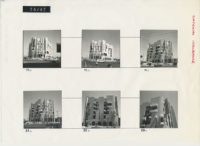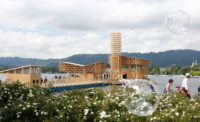In 2018, Frank Gehry’s 180-foot-tall Arts Resource Center, with towering swaths of pixelated-looking steel, is set to open on a 20-acre former train repair site in the South of France. It will be the centerpiece of LUMA Arles, an art and culture campus founded by Swiss collector Maja Hoffmann that is slowly taking shape on the site. But before the residents of Arles welcome the tower to their existing landscape of ancient Roman and Gothic architecture, they can now get an unusual introduction to its designer.
Inside the site’s Atelier de la Mécanique, a 43,000-square-foot garage that Selldorf Architects will eventually transform into galleries, a multi-part primer on Gehry’s work opened to the public on April 5 to coincide with the new building's groundbreaking. A second installment went up earlier this month, and both components will remain on view through October 26. The show, titled Solaris Chronicles, follows few norms of an architecture exhibition. Curated by artists Philippe Parreno and Liam Gillick, with help from Serpentine Gallery co-director Hans Ulrich Obrist, the show taps a star line-up of artists to present homages to Gehry’s oeuvre as well as complementary works of their own. It puts a spin on standard presentations of architecture with an exhibition that is—in every sense of the word—dynamic. The models, for one thing, dance.
Depending on the time you enter the massive space, you may see eight models of Gehry’s major works—the Guggenheim Abu Dhabi, Facebook’s West Campus Building, and an unrealized proposal for the National Art Museum of China, among them—engaged in a kind of ballet. Thanks to the wheels attached to the tables on which the models sit and to the rhythmic labor of a few Arles-based human handlers, the constructions have been moving since April in a dance imagined by Tino Seghal, an artist celebrated for orchestrating “constructed situations” that often involve performers and unfold over time. Their movements are set to a score by venerable French composer Pierre Boulez. Seghal gave the handlers a list of movements, but they decide which to put in motion and when. At one point, on a recent visit, as the Guggenheim Bilbao and the Disney Concert Hall came rushing together, they stopped just short of collision to twirl away in separate directions, bringing to mind a Sharks-versus-Jets situation from “West Side Story.”
At times, the models stand perfectly still, as if to invite closer inspection. “There are few moments in the show in which something is not moving,” however, says Solaris producer Asad Raza, who frequently coordinates the logistics of Seghal’s work. The exhibition’s roster—which also includes sound designers Nicolas Becker and Djengo Hartlap, film director David Lynch, and artists John Baldessari and Cai Guo-Qiang—have created what Raza calls a “collaborative experiment” of Gehry tributes.
The layering of these disparate works in the (constantly shifting) exhibition design sets the entirety of the show into a constant state of unfolding, making it look completely different at various points. Even when the works are still, the handlers out on their necessary cigarette breaks, a square lamp Parreno designed to traverse the length of the exhibition space—like an artificial sun—casts and recasts the models’ shadows about the room. Selections from the artist’s Marquee series—suspended light works crafted to evoke classic movie theater facades—hanging from various points in the ceiling light up in their own choreographed sequences, emitting the sci-fi sounds of their electrical operations, amplified and slightly tuned by Becker.
An event earlier this month introduced another set of layers to the spectacle: to fête the newly added model of the Quanzhou Museum of Contemporary Art, Cai provided an indoor pyrotechnic display of swirling, gunpowder-equipped mobiles (sadly, for one day only). Lynch unveiled noirish black-and-white close-ups of Gehry’s models, decidedly the least dynamic of contributions to the show.
The luminous, sonic, kinetic modes of animation express the motion already present in Gehry’s work. It also foreshadows the high-concept subversiveness that the directos of LUMA Arles have in mind for the campus. “They’re committed to making new and experimental forms of exhibitions,” said Raza, which includes an unorthodox approach to architecture exhibitions. “Seeing people pushing models is suggestive; you can think of the human as important too. Buildings are to be used and to be discarded if we don’t need them anymore,” or of course, as is the case in Arles, reincarnated.

















Post a comment to this article
Report Abusive Comment